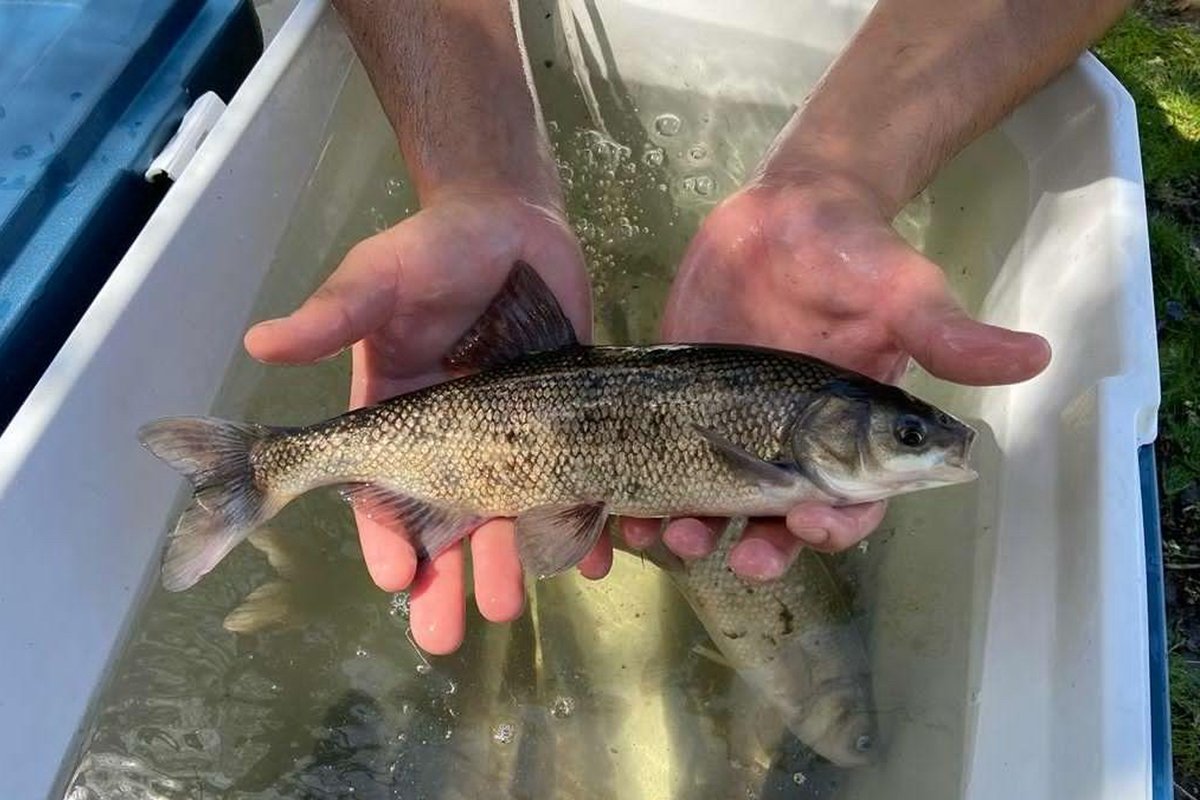The endangered fish benefited from last year’s wet winter, but the hitch needs more rainfall—and more support from water agencies and political leaders—to create a sustained comeback.

The endangered fish benefited from last year’s wet winter, but the hitch needs more rainfall—and more support from water agencies and political leaders—to create a sustained comeback.
January 30, 2024

A rescued hitch (Photo credit: Luis Santana)
A version of this article originally appeared in The Deep Dish, our members-only newsletter. Become a member today and get the next issue directly in your inbox.
One year after California state and Lake County leaders declared an emergency for the endangered Clear Lake Hitch (known as “chi” to local Pomo Tribes), more than a dozen agencies are collaborating in an all-hands-on-deck approach to save this culturally important fish, one intertwined with our destiny as Tribal peoples.
For millennia, abundant spring spawning runs of chi filled 14 tributaries feeding North America’s most ancient lake. Thousands of Tribal members gathered at Clear Lake to communally hand-harvest and process chi into fish jerky that provided year-long sustenance. Following successive genocides of Tribal communities, countless generations of sustainable fish harvests were erased by five generations of environmental damage: water diversions, invasive species introductions, and habitat destruction. Within our lifetimes, the chi spawning runs diminished to only six streams, and throughout the recent drought, we didn’t witness a single run.
“It will take years of juvenile recruitment—loads of healthy teenagers growing into reproductive adults—to ensure their future.”
In 2022, fearing for the chi’s future, Tribal members drove hundreds of miles to testify at agency meetings in Sacramento, Eureka, and South Lake Tahoe. Our efforts inspired a series of historical firsts: interagency hitch summits at Big Valley Rancheria in 2022 and Robinson Rancheria in 2023 resulting in novel, cross-agency collaborations, resource-pooling, and data-sharing to address persistent threats to the chi.
Reversing the damage is a complex undertaking. To understand how to maintain water flows in spawning streams for chi eggs to survive and emergent fry to make their way back to the lake, the California Department of Water and the State Water Resources Control Board are helping to install specialized equipment to monitor surface and groundwater in creeks and creekside wells. Lake County Water Resources and the California Conservation Corps are clearing tons of debris from waterways to improve fish habitat and water flow and reduce streambank erosion.
The U.S. Fish and Wildlife Service and the California Department of Fish and Wildlife (CDFW) allocated millions of dollars to identify and dismantle hitch migration barriers, complete a hitch conservation strategy, and fund the Robinson Rancheria Environmental Protection department to track and remove invasive carp, a chi predator known to grow up to 25 pounds and “vacuum up” thousands of chi eggs and young.
As we wrote about last year, an exceptionally wet spring in 2023 mitigated California’s drought and brought the welcome surprise of tens of thousands of hitch to lakeside streams. Yet heavy water flows generated a new emergency: Chi were swept over streambanks and stranded in ditches and fields. Tribal staff, accompanied by CDFW and landowners who reported strandings, ultimately rescued more than 26,000 chi.
The sudden appearance of high numbers of chi has scientists scratching their heads—there’s a working hypothesis that adjacent water bodies provided a refuge for adult hitch—and has some local residents, including farmers whose water use has come into question, suggesting that the crisis is not legitimate.
In a public meeting co-sponsored by the Lake County Farm Bureau, the audience was shown graphics illustrating hundreds of sampling sites throughout Clear Lake and nine years of hitch survey data using seine nets, electrofishing, and stream observations by U.S. Geological Service and CDFW fish biologists—all clearly pointing to severe hitch population declines. However, some audience members accused agencies of creating a false crisis based on “faulty data.”
We know that one year of good fish runs doesn’t mean our chi have recovered. It will take years of juvenile recruitment—loads of healthy teenagers growing into reproductive adults—to ensure their future. This year, although another wet winter has brought several feet of rain to Lake County, we haven’t yet seen the kinds of consistent water flows that are needed for the annual upstream migrations of the chi between February and June.
We are still waiting, watching, and praying for our chi. And whenever we see them again, we will sing them home.

September 4, 2024
By paying top dollar for milk and sourcing within 15 miles of its creamery, Jasper Hill supports an entire community.
September 3, 2024

August 27, 2024

August 26, 2024

Like the story?
Join the conversation.